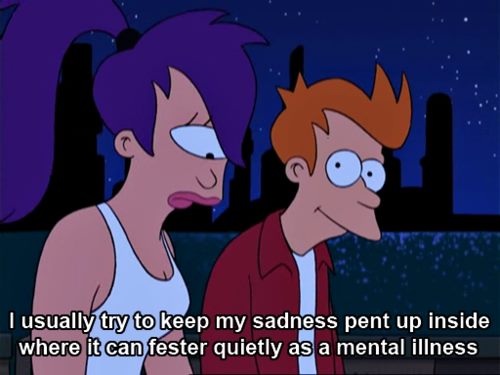63 Steps to Survive the Worst Moments of Your Life
Has something so horrible ever happened to you that made you think, “Fuck, this is the worst moment of my life”? Has life ever thrown at you a bag of lemons so huge it split your face in two?
If your answers are no, then you’re a lucky bastard (you won’t be for long). If it’s yes, join the club. We’ve all been there, we all know the insurmountable struggle to climb out of that wallowing hole of self-pity when life knocks you on your ass.
Whether you’re still in that hole or have turned a new leaf, here are 63 steps you can follow to survive your worst moments, as backed by science and me.
You’re welcome.
Step 1: Slap yourself in the face. Hard, preferably. Because if a slap in the face seems too painful to consider, then whatever problem you’re dealing with right now is really not that big of a problem. You’re likely just milking it for attention or the chance to feel sorry for yourself.
It’s only when you’re truly wallowing in the depths of pain and failure that you think, “Hah! Slap myself in the face? That’s nothing compared to my problem. Watch, I’ll do it three times.”
So either slap yourself or shut your mouth and get on with your life.
Step 2: Don’t compare your suffering to others. No, it doesn’t matter if your brother had something twice as bad happen to him last year. It doesn’t matter if your cousin got hit by a car and never complained about it.
You don’t actually know these things, so you don’t get to compare yourself to these things.
We all feel things slightly differently. Therefore we all suffer slightly differently. Stop measuring how much of a right you have to feel bad and just let yourself feel bad.
Step 3: Identify the feeling. What is it? Anger? Grief? Jealousy? Sadness? Despair?
Step 4: Don’t repress it. Repressing negative emotions kills you.1, 2 That’s kind of literal. That means if someone close to you asks, “How are things?” You respond with, “I feel like dog shit,” not with, “Oh, I’m greeeeeeat,” and then run away to cry into your cereal bowl and wonder why nobody in the world cares about you.

Speaking of which…
Step 5: Go ahead and cry if you need to. No shame. It’s healthy.3 We all need to cry sometimes.
Step 6: Seriously. Don’t worry. I won’t make fun of you. I promise.
Step 7: See, doesn’t that feel nice? You want some tissues? A hug maybe?
Step 8: Solicit Mark for a free hug. There may be some logistical issues involved, but whatever. It’s the thought that counts, right?
Step 9: Blame somebody else for all of your pain. Now that you’ve cried it out, let’s get to what’s really important: whose fault is this? Who is the idiot here? Figure out who that person is ASAP so we can lynch the bastard.
Step 10: Once you’ve figured out who to blame, immediately forgive that person. No matter how hard it is.4
Step 11: Identify what you could have done better. Maybe what happened to you wasn’t your fault, but that doesn’t mean that you couldn’t have handled it better. What did you mess up? What do you wish you could go back and change?
Step 12: Immediately forgive yourself too. We all could be better.5
Step 13: Understand that life has costs. Anything good in life requires some sort of risk or sacrifice. No exceptions. None of us make it through life without a few scars.
Step 14: Understand that pain, no matter how deep, eventually passes. Nothing lasts. It will eventually get better.
Step 15: Understand that at the bottom of every shithole there’s buried gold. Stop trying to climb out and start looking for it.
Step 16: Tell somebody close to you how you feel. Expect nothing from them in return. If they don’t hug you, I will.
Step 17: Tell them “I’ll Be OK” even if you don’t believe it yet. Because you’re right, you will be OK. Even if you’re dying, you will be OK.
Step 18: If you have nobody to tell how you feel, then talk to a therapist or a support group. There’s a support group for practically everything these days. Maybe go to one even if you do have somebody to talk to.
Step 19: If you’re nervous about the whole therapist/support group thing, print out copies of this picture of a dog in a taco suit and show it to everybody when you arrive.

Step 20: OK, you don’t have to do that. But it’s funny to think about.
Step 21: Promise yourself that you’ll do something nice for somebody less fortunate than you. Nothing makes us happier than when we make others happy.6 Donate to a charity. Give someone a gift. Buy a homeless man a haircut.
Step 22: Then actually go do it.
Step 23: Don’t tell anybody you did it. Don’t take a selfie of you and the homeless man and his new haircut and post it on Facebook. Keep it as your own special secret.
Step 24: Don’t be afraid to be alone sometimes. Become your own best friend.
Step 25: Come up with three life lessons from this shitty situation. This is the hard work. This is the unfun stuff. It’s so much easier to hop online and blame someone and post angry comments on Reddit and YouTube. But this is the most important step. So take it seriously.
What can this horrible experience teach you? How can you use it to make something better of yourself? Come up with three ways. Write them down if you need to.
Step 26: Promise yourself that you’ll take advantage of these lessons and be better next time.
Step 27: Tell yourself that it’s actually good that this god awful thing happened to you and that maybe you will be grateful for it one day.
Step 28: Then realize that you’re probably lying to yourself. Sometimes things just suck.
Step 29: Refrain from stabbing somebody, including yourself. This one is important.7
Step 30: Understand that most things in life are both good and bad at the same time. What changes is our perspective.
Step 31: Pour yourself a drink. But skip this step if you are: a) an alcoholic, b) have a medical condition that prevents alcohol use, c) already drunk, or d) 12-years-old.
Step 32: Take a moment to think about all of the things in your life that are amazing. If you can’t think of anything, think harder. This article might help.
Step 33: Consider how fortunate you are to have those amazing things in your life. I mean, you could have been born in 14th century Africa and had your penis cut off.8
Step 34: Come up with three ways your life could be way, way, way worse. There’s always a worse.
Step 35: If you can’t come up with anything, take an afternoon and go visit your local children’s cancer ward.
Step 36: Or just google it and then lie and say you visited one.
Step 37: Start feeling really guilty once you realize you’re not a child who has fucking cancer.
Step 38: Immediately forgive yourself.
Step 39: Pour yourself another drink. Cancer sucks.
Step 40: Watch this video of a cat in a shark suit chasing a duck on a Roomba.
Step 41: Understand that the internet is frickin’ amazing.
Step 42: But don’t post some wishy-washy thing on Facebook looking for sympathy. That’s shallow and counter-productive.
Step 43: And don’t go trolling other people and using your sadness/anger/hate as an excuse to fuck with other people, even if online.
Step 44: Don’t give in to the urge to stereotype. The internet makes this too easy. Just because your wife left you doesn’t mean all women are superficial whores. Just because your friends didn’t know how to act at your dad’s funeral doesn’t mean people are shallow and heartless. The world is a complicated place.
Step 45: Tell your mother you love her. Email her. Call her. Text her. Whatever, she’s your mother. If you don’t have a mother, tell your sister. If you don’t have a sister, tell your best friend. If you don’t have a best friend, tell the mailman.
Step 46: Understand that mailmen need love too. We all do.
Step 47: Practice patience. Pain takes time to resolve. There are 63 steps on this thing for a reason.9
Step 48: Do something nice for yourself. Eat some ice cream. Play some video games. Masturbate. Or do all of the above at the same time.
Step 49: If you still feel shitty, then sleep on it.
Step 50: If you can’t sleep, make sure you stopped drinking.
Step 51: Set your alarm the next morning. Get up and make sure you do something useful and productive first thing, no matter how awful it feels and no matter how much you don’t want to. Even if it’s a small thing.
Step 52: Meditate.10
Step 53: Sing your favorite song at the top of your lungs. It’s a new day! Preferably do it in the shower or car so nobody has to listen to you.
Step 54: If you haven’t already, now is the time to stop crying. If you can’t, return to Step 7 and repeat the process until you do.
Step 55: Remember those three lessons you used to convince yourself that this was a good thing for like two minutes yesterday? Decide how you can implement one of those lessons today and then go do it.
Step 56: Repeat Steps 47-55 for anywhere from the next three weeks to the next three years. It’s OK. We’ll wait for you.
Step 57: Remember: patience.
Step 58: Get out of the house and go be social. Even if you don’t want to.
Step 59: When you’re with a group of people who like you, tell them about the painful horrible thing that happened a while back. Tell them something funny about it. Laugh together about it.
Step 60: Laugh at how much you cried. Laugh at how you couldn’t sleep. Laugh at how you masturbated while eating ice cream.
Step 61: Realize that you’re not alone. People care. Even if they don’t always know how to show it.
Step 62: Realize that in hindsight, the pain is always far less important than it first seemed.
Step 63: Realize that your problems are not special or unique, that you are not special and unique. And this is good news. Because it means that you will never ever have to suffer alone.
- Petrie, K. J., Booth, R. J., & Pennebaker, J. W. (1998). The immunological effects of thought suppression. Journal of Personality and Social Psychology, 75(5), 1264.↵
- Nezlek, J. B., & Kuppens, P. (2008). Regulating positive and negative emotions in daily life. Journal of Personality, 76(3), 561–580.↵
- Pennebaker, J. W., Zech, E., Rimé, B., & others. (2001). Disclosing and sharing emotion: Psychological, social, and health consequences. Handbook of Bereavement Research: Consequences, Coping, and Care, 517–543.↵
- Forgiveness is often tricky business and takes months or years if someone has seriously hurt you. Best way to start forgiving is to recognize how the other person suffers as well. Often people hurt us because of the ways they’ve been hurt themselves.↵
- Neff, K. D., & McGehee, P. (2009). Self-compassion and Psychological Resilience Among Adolescents and Young Adults. Self and Identity, 9(3), 225–240.↵
- Aknin, L. B., et al. (2013). Prosocial spending and well-being: Cross-cultural evidence for a psychological universal . Journal of Personality and Social Psychology, 104(4), 635.↵
- For people who are seriously considering hurting themselves:
In the US, call 1-800-273-8255 to reach the National Suicide Prevention Lifeline
Find a suicide lifeline outside of the U.S.
Find a support group.↵ - I actually have no idea if they cut off people’s penises in 14th century Africa. You get the idea though.↵
- Actually, there’s absolutely no reason this thing has 63 steps. I’m making it up as I go along.↵
- Read about the ridiculous benefits of meditation here and here.↵
